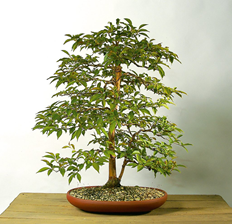If one were to hold a bonsai popularity contest, junipers would head the list and for good reason. They are readily available, gladly suffer all sorts of horticultural indignities and with a modest amount of imagination can quickly become really cool bonsai. Close behind the junipers is the trident maple for similar reasons. Somewhat behind these two are a host of the usual suspects such as pine, quince elms etc. Lurking in the far background are a few trees that are only rarely seen as bonsai and have wonderful qualities that are overlooked. Among these trees is the Japanese Stewartia.
Stewartias are close relatives to the Camellias. There are several species of Stewartia, two of which are native to the United States. The first Stewartia species to be described was discovered by the early plant explorers in the United states back in colonial days. It was only later that other species were discovered in Asia. Plants sold as Japanese Stewartia in the horticulture trade are actually either of two species, S. monadelpha and S.pseudocamellia which are mainly slightly different in matters of interest to only a botanist. The true S. monadelpha has somewhat smaller leaves which makes it the slightly more attractive of the two as bonsai material.
What makes the Stewartias of interest to the bonsai artist is that they are camellias in technicolor. Camellias are evergreen but in contrast, Stewartias are deciduous and in the fall the leaves turn a gorgeous red color before dropping. But wait, there is more. Camellias have boring gray bark. Stewartia have a reddish bark which flakes off. The bright pealing bark is somewhat similar to the more familiar Sycamore tree but more colorful. The tree bares white flowers in July which closely resemble Camellia flowers. It is reported that sometimes the flowers are fragrant.
The culture of these trees is very much like that of azaleas. They need a constantly moist somewhat acid soil and quickly show their displeasure when allowed to dry out. A cool root zone is a requirement so growing them in the hotter part of our area may take some care, particularly shading them during the hottest part of the day. Stewartias are naturally small trees and like to act like a small tree by sending out long branches. To retain shape as a bonsai the branches can be treated in the same way as elm branches, that is, let the branch grow out to 5 or six sets of leaves and then cutting back to two leaves. Flowers are produced on new wood but not on the tips of the branches, so it is possible to maintain bonsai shape without sacrificing flowers. Cutting back the branches causes a lot of branch buds to grow and leads to the fine branch structure which we want for a fine bonsai but can cause the inner branches to be so shaded that they die out. Fortunately, Stewartias are quite amenable to defoliation by cutting the leaf in half. This allows light to penetrate into the center of the tree. The natural leaves of the tree can vary in size from an inch and a half to as big as four inches and defoliation also reduces the size to a more manageable scale for the tree.
Stewartia seeds are readily available in line. We usually do not bother with sewing seed for our bonsai material but in this case, Stewartia seedlings can make a terrific group planting and growing seeds is a way of producing material for a group planting. The seed can be a bit of a challenge to germinate but soaking them in water for a few days before sowing them helps.
Stewartias are trees with year around appeal with fall colors, summer flowers and beautiful bark. They are truly a tree for all seasons. They should be seen a lot more often as bonsai. If you see one at a sale, do not pass it by.


